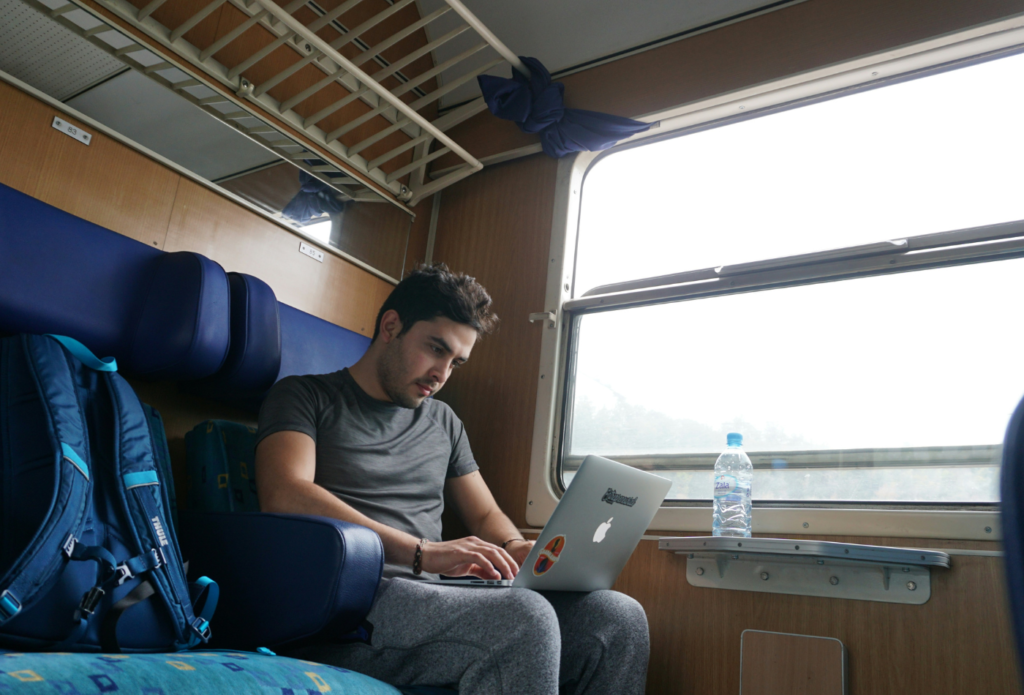
Travel blogs are crucial to the marketing funnel for travel agents and leisure brands. In this blog, we dive into how to write a travel blog post, why they’re essential, and share our top travel blog writing tips to help you reach your target audience at each stage of the buying journey.
Before a person books a holiday, they usually go through the five steps of travel buying:
- Dreaming
- Planning
- Booking
- Experiencing
- Sharing
Searching for and reading travel blogs can happen almost anywhere during this process, so when planning your content strategy, you should consider titles that hit potential customers at each touchpoint.
While some individuals read travel blog posts for inspiration and advice, travel bloggers share their experiences abroad in hopes of attracting the latter’s attention. And for consumers looking to experience the endless variety of cultures worldwide, having access to the right resources will help them make the right decisions.
Why is travel blogging so popular?
According to Expedia Group, digital travel content grows by double-digit percentages every year. With this rising number of travel blogs found online, there is a growing audience to match it. People engage with travel content to feel something.

In The Wanderess, a popular mystery novel set in the Mediterranean, Roman Payne writes: “A person does not grow from the ground like a vine or a tree, one is not part of a plot of land. Mankind has legs, so it can wander.” However, for many, travel is a luxury; it’s a dream, a bucket list checkpoint, or a savings pot goal. It’s a list of aspirations we add to across our lives.
Because of this, many consumers will spend more time in the ‘dreaming’ or ‘planning’ stages of travel than they ever will jet-setting across the globe. But that’s what makes it unique. And it’s this anticipation that encourages users to read travel writing and blog content online.
Why should you have a travel blog on your site?
A good travel blog on your site can make all the difference. While it’s an investment of resources, the benefits outweigh the effort to keep it going.
Search Engines work to answer questions and queries inputted by their users. These requests can be categorised by search intent. In the ‘dreaming’ or ‘planning’ stages of travel, users will slowly filter their way into the top of the marketing funnel.
Here is where informational searches sit, which include your queries like “Best places to visit in the winter” or “Where to travel for less than £300”. As either of the latter is typed into the search bar, Google (or another search engine) is going to do its best to deliver results that it knows will contain the answers the user is looking for; they’re going to list blogs, articles and resources that they can guarantee are of high value, with the best in prime position at the top of the SERPs.
To rank content by its value, Google says its “automated systems are designed to use many different factors to rank great content. After identifying relevant content, our systems aim to prioritise those that seem most helpful. To do this, they identify a mix of factors that can help determine which content demonstrates aspects of experience, expertise, authoritativeness, and trustworthiness”.
The better your content, the higher your rankings. And with higher rankings, your brand will command more authority in the SERPs. How often do you scroll past the first page of results? Pretty much never, right? When debating how to write a travel blog, SEO should be at the forefront of your article idea.
If your brand sits stagnant on page ten, it’s going to limit traffic and conversions. You’ve got to think of it as a little like dominos. As you publish travel blogs that Google can confidently share with its users, Google will reward you by showing it to more people, and as more people land on your site, the likelihood of them sticking around increases. It’s a knock-on effect of SEO success – and one you should not sleep on.

How often should you post content on your travel blog?
Blogging can feel like a pretty big task – and it is a commitment. You must be consistent if you want to drive results from your travel blog. You can’t post a few times a year and expect a great return. When it comes to how regularly you should blog, you need to find the sweet spot between quantity and quality.
Different sources will recommend different things. Some suggest two to four high-value posts a week, while others say one a month will do. For smaller companies, the former may be unachievable; for the more prominent brands, the latter may feel like you’re wasting precious resources. Consistent can have different meanings, but for the sake of your travel content, pick a regular posting schedule and stick to it.
Frequency of publication, length of blog and subject matter will, of course, depend largely on your budget. You need to be realistic – the more significant you need your reach to be, the more you must commit. Big brands must cover all the bases – destination pages, FAQs, guides, etc.- covering multiple, highly competitive keywords. Dominating popular search terms takes investment. Having written for several large travel brands, including Thomas Cook and Expedia, we know it’s something of an arms race, with companies producing hundreds of thousands of words per year. Even in this highly competitive area, we know there are still successes to be had. However, in our opinion, many large brands are still getting it wrong by not thinking carefully about authenticity, originality and creativity in their travel blog post writing. There are productive keywords to be mined if you know where to look!
Smaller brands can still compete – they just need to be clever with their content strategy, focus on a niche and find less competitive keywords for where they can outperform. Often, smaller brands possess unique, hard-won insight into a particular country or region, resulting in better insight, inspiring local knowledge, or a compelling tone of voice, etc, that can be more appealing than a generic blog.
What makes a good travel blog post?
Anyone can write a travel blog post. But not everyone can deliver effective travel blog writing that compels users to take action – or, in other words, book that flight or cruise of an all-inclusive getaway. An effective travel blog strikes the balance between experience and information perfectly. While it shouldn’t be a monotone reciting of the Yellow Pages, it must feel familiar. And while it shouldn’t be a poetic retelling, it needs to be descriptive, focus on imagery and be able to elicit a little emotion. The specific needs of each travel blog will depend significantly on the type of travel blog you write, which seamlessly transitions us to our next point…

The different types of travel blog post
The types of travel blog post you choose will depend on what you want to write. And each one serves a specific purpose that pretty much speaks for itself:
Destination guides
These are comprehensive guides to specific destinations, revealing detailed insight into the best attractions, accommodation, local cuisine and any important tips a holidaymaker may need to know before travelling. Writing a travel blog post on a destination is one of the most common types of travel article on the internet.
Take a look at this Ibiza destination guide by Lonely Planet.
Travel Itineraries
These posts are slightly more instructional. A step-by-step plan for a trip often includes activities, timelines and tips for maximising your travel experience. They’re usually geared towards a specific demographic, budget or interest.
Take a look at this France 10-day itinerary written by Trainline.
Travel list posts
These travel blog posts are easy to consume and quick to read. They usually list several travel tips, hacks or places to see in a specific area. A shorter post may delve into the ‘Top ten places to visit in London” while a longer post might explore “100 things to do when travelling around South East Asia”.
Take a look at this ‘10 best places to visit in Europe’ blog by Holiday Cars.
Comparison posts
Comparison posts do what they say on the tin – compare various travel options. From hotels to destinations, these travel blog posts are geared towards individuals who need a little help making up their minds.
Take a look at this hotel comparison article by the Telegraph.
Travel journals
Travel Journals can be a mix of all of the above; however, unlike destination guides and travel itineraries written solely for the reader, travel journals tend to be a little more personal to the writer. These can be particularly authentic for holidaymakers who want recommendations to feel like a local and want to explore locations off the beaten track.
Take a look at this travel diary by Finns Away.

Choosing a travel blog topic
Choosing the right things to talk about on your travel blog makes all the difference. Your blogs need to be appropriate, make sense of your products or services, and be written with your audience in mind. The latter is crucial, and if you are yet to pinpoint your target customer, we wrote an in-depth content marketing guide that will help. Your audience is what, ultimately, underpins your entire content marketing strategy. You can’t and shouldn’t be guessing when creating content for them. Writing a travel blog post is no different. You wouldn’t expect a Caribbean cruise line to write a travel blog post on the top ten destinations for skiing holidays as much as Disney World wouldn’t write a destination guide for lads’ holidays.
So, with that in mind, to choose your topics for your travel blog, you should:
Analyse existing data
What content has your audience responded to in the past? If you’re yet to launch your blog, you’re probably not going to have any blog content to compare. However, look at your newsletter analytics, social media engagements and website traffic to see what people are reading. This will give you a good idea of what those who already know about you may be likely to read. Tools like Brandwatch or Hootsuite can help monitor social media conversations related to your brand, uncovering trending topics and discussions within your target audience.
Do your keyword research
Not only is this extremely important for the effectiveness of your SEO strategy, but it also gives you a solid idea of what people in your target audience are searching for and a rough guide on how to reach new audience members. Before writing a travel blog post, use tools like SEMrush, Ahrefs, or Google Keyword Planner to identify high-ranking keywords related to the brand’s offerings. Target long-tail keywords with a medium search difficulty for your best chances of ranking in the SERPs. For a more in-depth overview of how to get your content to rank in Google, read our guide.

Sample travel blog topic ideas for your inspiration
Once you have your target keywords and audience data, you can create your punchy title. Your blog heading needs to persuade readers to read your blog. While short and snappy can capture the attention of individuals, as a rule, and according to SEMrush, headlines with 10-13 words attract two times as much site traffic and 1.5 times as many shares as those under seven words. Your headline should:
- Define what the article is about
- Demonstrate its value
- Use words or phrases that resonate with your audience
- Ask questions
- Use numbers – but be quantifiable (where appropriate)
- Be concise and to the point
- Include your target keyword
Here are a few tried and tested headline templates for your travel blog writing:
- The ultimate guide to [Destination]: Must-see attractions and insider tips
- How to explore [Destination] like a local
- [Number] tips for [Activity/Interest] enthusiasts in [Destination]
- The [Adjective] traveller’s guide to [Destination]
- [Year] Travel trends and why you need to follow them.
- [Number] best things to do in [Destination]
Planning your titles and target keywords intelligently will save you time and stress. Not only will it make briefing your copywriters a lot easier, but it will also allow you to create and schedule content in advance. There’s nothing worse than the last-minute sprint to get content ready with a moment’s notice.
How to write an effective travel blog post
So, how do you write a travel blog post? Here are our top tips:
Choose the right writer
Although these tips may help, if you’re not a writer, it is worth considering hiring support from someone who is. But who do you hire? For larger brands, who are more likely to have the budget, we recommend someone with real hands-on experience. The best way to get that experience? Visit the country or place you are about to write about.
Now, hear us out. It might sound a little extreme for a travel agent to send a copywriter abroad. However, if planned and briefed thoroughly, it can be an effective way to produce authentic content. Say you are an airline that frequently flies to Malta. A Google search will show you that there are hundreds of blogs regurgitating a combination of information held by Google Maps and Expedia. It’s dry, it’s boring, and while most writers are doing their best to jazz things up, you can often tell it was written from the not-so-sunny London office. Why? Because it lacks real experience.
Your audience wants to know what it’s like to visit that tropical destination at the top of their bucket list. But they also want to feel what it’s like; they want to feel that tinge of jealousy that pushes them to part with their hard-earned cash. And the best way to get that across in your copy is to hire a writer with first-hand experience in the destination.
If you choose to head down this route, as we mentioned before, we can’t stress enough the importance of an excellent brief. Build a detailed content plan, give your writer a clear checklist of the content you expect while travelling, and realistically plan the blog topics you can cover with the content they create while away. Start from the trip to the airport, cover the journey to the hotel, and the food at the resort, and finish with the compulsory visit to duty-free on the way home. Maximise on gaining as much information as possible so they can write plenty of detailed travel blogs. Ask them to take original photos and consider writing an itinerary for their stay.
Shipping off a writer and all expenses paid may be an unreasonable expense for some brands, but you should, at minimum, hire a copywriter who specialises in travel. Look for someone who is well-travelled, making producing content about the places they’ve visited much easier. Or get an agency like Big Star that has written millions of words of travel content and hires writers with specialist destination knowledge.

It needs to be original
“Every Englishman abroad, until it is proved to the contrary, likes to consider himself a traveller and not a tourist.” ― Evelyn Waugh, Labels
This links closely to our last point. If you’re unable or unwilling to send someone abroad to act as a detective and find the best tourist hotspots and local treasures, thorough research will be your next best friend. To find attractions, destination highlights and local treasures off the beaten track, you must navigate a similar route when researching.
Turn to personal travel diaries, native information sites and social media to discover unique and wonderful places and experiences. Be inventive with your research, speak to local business owners via social media, and connect with Brits who have moved abroad. Your writing should feel familiar, like you’ve walked the route a thousand times. That’s the key to building trustworthy content.
Tell a story
Facts are 22x more likely to be remembered if they are part of a story. And your travel blog should have a clear beginning, middle and end. A blog entices readers when they are invested in what happens next. Stories can also include some sort of conflict, and if you’re looking for an honest travel journal for your site, then be prepared to cover the cons as well as the pros. Readers will have a lot more respect for a brand if they’re truthful, and you’d be surprised how many people would appreciate a brief ‘This place might not be for you if…’ before they commit to spending a significant amount of money on an abroad stay.
Don’t scrimp on detail
If someone can visualise something – if they can see themselves dipping their toes in the golden dunes of Turkey – they’re more likely to yearn for that experience. When writing your travel blog, you shouldn’t scrimp on detail. Paint a clear picture, and inject your copy full of adjectives. Your travel blog writing should be cinematic and immersive; it should transport your readers across the sea and give them a taste of what they can expect.
Choose the right words
Your tone shouldn’t be too formal when writing your travel blog. While luxury destination travel writing should set a precedent for the level of service travellers should expect, a conversational tone is preferred amongst many readers. If you approach your writing as if talking to a friend, convincing your reader to take the leap and book the holiday suddenly becomes much less daunting. It’s also a lot more enjoyable to read.
Optimise your blog for SEO
Keywords aside, your blog should be SEO-optimised if you want any chance of ranking in the search results.
- Integrate keywords naturally throughout your content, including the title, headings and throughout the body of the post. Avoid keyword stuffing and use a tool like Yoast SEO to ensure you’re optimising it as much as possible.
- Write a compelling meta title that includes your primary keyword. Keep it under 60 characters to ensure it displays correctly in search results.
- Also, you need to write an intriguing meta description. Keep it under 155 characters and use words that summarise the content while encouraging clicks.
- Write an engaging URL structure. Create a clean and readable URL that includes the main keyword. Use hyphens to separate words and keep it concise.
- Use header tags to structure your content. The main title should be in H1, followed by relevant subheadings (H2, H3, etc.). Include keywords where relevant.
- Compress images to reduce file size for faster loading times. Use descriptive filenames and include alt text that describes the image using relevant keywords.
- Include internal links to other relevant posts on your blog. Also, link to authoritative external sources when applicable. This helps search engines understand the context of your content.
We wrote a free SEO content checklist to help you optimise your website content for SEO. You can download that here.

Look for opportunities to recycle content
Lastly, you should always look for opportunities to recycle content. That destination guide you wrote can be turned into a “Top Ten Places To See in [Destination]” blog post. Alternatively, that first-person travel journal can be transformed into a “Discover [Destination] Like A Local” guide. Think beyond the first blog you write and consider your long-term strategy.
Measuring the success of your travel blog
If you don’t measure the success of your blogs, you won’t be able to track positive changes to your site’s ranking or performance. Here’s a quick guide to tracking analytics:
Tracking website traffic
- Metric to check: Website visitors
- What to analyse: Monitor the overall traffic to your blog, including the number of visitors, page views, and bounce rate.
- Tools to use: Google Analytics
Tracking engagement metrics
- Metric to check: Time on page, comments, social shares
- What to analyse: Assess how engaged your audience is with your content. Longer time on the page, high comment counts, and social shares indicate a more engaged audience.
- Tools to use: Goole Analytics
Tracking conversions
- Metric to check: Conversion rate
- What to analyse: If your blog has specific goals (e.g., newsletter sign-ups and affiliate clicks), track the conversion rate to measure the effectiveness of your calls-to-action.
- Tools to use: Google Analytics Goals, Conversion Tracking Tools
Tracking keyword rankings
- Metric to check: Keyword rankings
- What to analyse: Monitor how well your blog post ranks for the targeted keywords. An improvement in rankings can indicate successful SEO efforts.
- Tools to Use: Google Search Console, SEMrush, Ahrefs
Tracking backlinks
- Metric to check: Backlinks
- What to analyse: Track the number and quality of backlinks pointing to your blog post. Quality backlinks can boost your post’s authority.
- Tools to Use: Ahrefs, Moz, SEMrush
Examples of excellent travel blog writing
It helps to have real-world inspiration when writing. We wrote a blog with travel blog examples that set a good benchmark. We recommend immersing yourself in well-written travel writing before you dive into writing or commissioning your own. Get a good feel of what works well and what doesn’t. Having this awareness will be beneficial in the long run.
How can we help?
Thanks for reading our guide on how to write a travel blog post. If you’re unfamiliar with travel blog copywriting, hiring a copywriter can relieve the stress of navigating new territory. That’s where we come in. Since 2005, we’ve written literally millions of words for some of your favourite brands. Our team is passionate about jet-setting globally, and we know how to craft excellent copy that will resonate with your audience. The right words can sell a destination, and we’d love to help your travel blog take off. Get in touch

very informative and insightful content guys